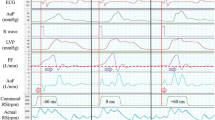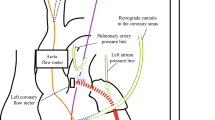Abstract
The algorithm for the physiological control provided by left ventricular assist devices (LVADs) has been controversial. In particular, little is known about the physiological control algorithm (such as for achieving physiological circadian rhythms) in continuous-flow LVADs. To investigate the existence of circadian variation, we retrospectively evaluated the LVAD flow-correlated motor current of patients supported by continuous-flow LVADs. The motor current and the pump speed were collected from the external controller every 10 min after device implantation, and the data were divided for every 30-day period, which began on midnight on the first post-operative day. The subjects were 18 patients (mean age 37.7, mean body surface area 1.71 m2 at the time of operation) with dilated cardiomyopathy or dilated phase of hypertrophic cardiomyopathy. As of August 1, 2013, the patients’ median support duration was 889 days. The mean calculated dominant period of motor current variation was 24.0 h and the mean amplitude was 11.7 mA for the entire duration. The amplitude of the motor current circadian variation tended to be increased until around the fifth month. The motor current had a tendency to be relatively low during the night time and high during the day time. A significant difference was found between the night-time and day-time mean motor current for the entire duration (p < 0.05). In conclusion, the circadian variation of the motor current could be observed over long term in patients with fixed rotation speed continuous-flow LVAD support.





Similar content being viewed by others
References
Tsukiya T, Akamatsu T, Nishimura K, Yamada T, Nakazeki T. Use of motor current in flow rate measurement for the magnetically suspended centrifugal blood pump. Artif Organs. 1997;21:396–401.
Tsukiya T, Taenaka Y, Nishinaka T, Oshikawa M, Ohnishi H, Tatsumi E, et al. Application of indirect flow rate measurement using motor driving signals to a centrifugal blood pump with an integrated motor. Artif Organs. 2001;25:692–6.
Slaughter MS, Ising MS, Tamez D, O’Driscoll G, Voskoboynikov N, Bartoli CR, et al. Increase in circadian variation after continuous-flow ventricular assist device implantation. J Heart Lung Transpl. 2010;29:695–7.
Refinetti R, Lissen GC, Halberg F. Procedures for numerical analysis of circadian rhythms. Biol Rhythm Res. 2007;38:275–325.
Sehested J, Happe E, Ishino K, Hetzer R, Schiessler U, Schifter S. Diurnal variation in blood pressure in patients with biventricular assist devices and retained, nonpumping native hearts. Circulation. 1994;89:2601–4.
Compostella L, Russo N, Setzu T, Tursi V, Bottio T, Tarzia V, et al. Cardiac autonomic dysfunction in the early phase after left ventricular assist device implant: implications for surgery and follow-up. Int J Artif Organs. 2013;36:410–8.
Hetzer R, Muller JH, Weng Y, Meyer R, Dandel M. Bridging-to-recovery. Ann Thorac Surg. 2001;71:S109–13 (discussion S14–S15).
Khan T, Levin HR, Oz MC, Katz SD. Delayed reversal of impaired metabolic vasodilation in patients with end-stage heart failure during long-term circulatory support with a left ventricular assist device. J Heart Lung Transpl. 1997;16:449–53.
Maybaum S, Mancini D, Xydas S, Starling RC, Aaronson K, Pagani FD, et al. Cardiac improvement during mechanical circulatory support: a prospective multicenter study of the LVAD Working Group. Circulation. 2007;115:2497–505.
Hu SX, Keogh AM, Macdonald PS, Kotlyar E, Robson D, Harkess M, et al. Interaction between physical activity and continuous-flow left ventricular assist device function in outpatients. J Card Fail. 2013;19:169–75.
Hermida RC, Ayala DE, Portaluppi F. Circadian variation of blood pressure: the basis for the chronotherapy of hypertension. Adv Drug Deliv Rev. 2007;59:904–22.
Carvajal R, Wessel N, Vallverdu M, Caminal P, Voss A. Correlation dimension analysis of heart rate variability in patients with dilated cardiomyopathy. Comput Methods Programs Biomed. 2005;78:133–40.
Acknowledgments
This work was supported by Grant-in-Aid for Scientific Research (B) from the Ministry of Education, Culture, Sports, Science and Technology of Japan (No. 19390343).
Conflict of interest
Dr. Kenji Yamazaki is a consultant for Sun Medical Technology Research Corp. The other authors have no conflicts of interest to disclose.
Author information
Authors and Affiliations
Corresponding author
Rights and permissions
About this article
Cite this article
Suzuki, K., Nishinaka, T., Miyamoto, T. et al. Circadian variation of motor current observed in fixed rotation speed continuous-flow left ventricular assist device support. J Artif Organs 17, 157–161 (2014). https://doi.org/10.1007/s10047-014-0762-4
Received:
Accepted:
Published:
Issue Date:
DOI: https://doi.org/10.1007/s10047-014-0762-4




